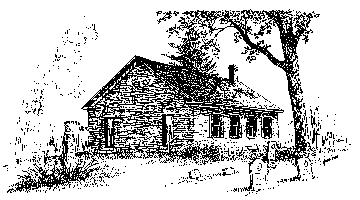The Wyandot Indians moved into Ohio in the mid-eighteenth century from Canada and Michigan. They settled on the Sandusky Plains. Their encounter with Methodism came in 1816, in the person of John Stewart.
Stewart (1786-1823) was a mulatto, of African and probably East Indian descent. He was converted at a Methodist camp meeting near Marietta, Ohio, and soon heard a call to preach. In response to an inner leading, he set off into the Ohio wilderness, traveling some 200 miles until he came to the Wyandot settlement.
His preaching, his beautiful singing voice, and his personality eventually brought a number of people into the Methodist fold. Word of his successful work reached the general church, which responded in 1819 by forming a Missionary Society to support Stewart’s work among the Wyandots. The Wyandot Mission thus became the first churchwide mission of the Methodist Episcopal Church.
John Stewart’s health was never robust, and he was forced to retire while still a young man. His friends collected enough money to buy him a small farm, where he lived with his wife until his death in 1823. He was thirty-seven years old.
By that point, leadership of the mission had passed to James B. Finley (1781-1856) Finley came to the mission in 1821 in response to the Wyandots’ request for a school. The following year, Finley and some of the chiefs travelled to Washington where they asked to use government funds to build a church. They received just over $1,000, and built a limestone meetinghouse that was dedicated in 1824. Finley stayed with the mission until 1827.
“[T]he house was built out of good limestone, thirty by forty feet, and plainly finished. So these people have had a comfortable house to worship God in ever since. It will stand, if not torn down, for a century to come.” From James B. Finley’s 1840 history of the Wyandot mission.
The mission continued until 1843, when the tribe was forced to emigrate to Kansas. Two acres of land on which the church and the burial ground stood were deeded to “the Methodists.”
The church was abandoned for some forty years, and deteriorated badly. In 1889, it was rebuilt on the same site using the original stones. Additional renovations were done in 1983.
Points of interest at this Heritage Landmark: The mission church was built in 1824 and restored in 1889 and 1983. Marble tablets on the back of the building give the names and dates of missionaries and others important in the history of the mission. The interior is furnished with a wood-burning stove and walnut benches, and there are photographs and artifacts on display. The cemetery contains the graves of Wyandot Christians and the missionary John Stewart.
The property is owned by the National Division, General Board of Global Ministries, The United Methodist Church.
Parking is available on Church Street or near the church at the cemetery. Restroom facilities are available when the Mission is open; there are also very limited restroom facilities at the cemetery.
Special events: Worship services are held at 8:00 a.m. each Sunday from June 1 to August 31.
Area attractions: The towns of Findlay, Lima, and Marion are nearby. Other Heritage Landmarks in Ohio are the Hanby House and the Bishop Seybert/Flat Rock Cluster.
To visit: The Mission is open Friday, Saturday, and Sunday, June 1 to August 31, from 1:00 to 4:00 p.m. At other times, visitors may make appointments by contacting Jean S. Moon (see address below).
Location: Within the boundaries of the West Ohio Annual Conference in Wyandot County, Ohio. The building is on East Church Street in Upper Sandusky.
Food and lodging: There are several eating places and motels in Upper Sandusky. Visitors will also find restaurants and motels in Bucyrus (16 miles east), Findlay (24 miles northwest), and Marion (20 miles south).
Directions: Take Interstate 23 to the Route 30 exit; travel two miles west to the edge of Upper Sandusky. Turn right at the second street (Fourth Street); follow Fourth Street several blocks to where it ends at Church Street. The mission is directly ahead in the cemetery.
Coming from the west on Route 30, turn left on Warpole; go north one block to Church Street, then turn right and follow Church Street to the cemetery and mission.
For further information, contact: Jean S. Moon, 127 South Eighth St., Upper Sandusky, OH 43351-1352 or the John Stewart United Methodist Church, 419-294-2867.
To learn more about United Methodist church history in this area:
West Ohio Annual Conference Archives, The Archives Center, Ohio Wesleyan University, Delaware, OH 43015; 614-368-3285.
Thelma R. Marsh, Moccasin Trails to the Cross: A history of the Mission to the Wyandott Indians on the Sandusky Plains (Upper Sandusky, OH: John Stewart United Methodist Church, 1974).
Joseph Mitchell, The Missionary Pioneer, or, A Brief Memoir of the Life, Labors, and Death of John Stewart, Man of Colour (Austin: The Pemberton Press, 1969; Reprint of 1827 original).

